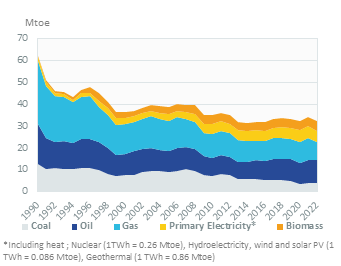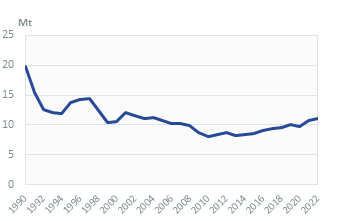-
-
 Energy and Climate Databases
Energy and Climate Databases- The most comprehensive and up-to-date annual energy database.
- Monitoring of technology providers in H2 supply chain.
- Monthly energy data on key energy markets.
- The most reliable and up-to-date power generation database.
- The essentials of LNG trade at your fingertips.
- Global monitoring of new and existing refineries.
- Analyse energy consumption and efficiency trends at world level. Benchmark countries.
- Have your database developed by a recognised expert of both energy and IT.
-
 Energy - Climate Forecasts
Energy - Climate Forecasts- Instant access to energy and emissions forecasts.
- Strategic, annual wholesale price projections backed by Enerdata's energy modelling expertise and our globally recognised POLES model.
- Wedges module showing a breakdown of the levers enabling to reduce emissions between two scenarios.
- Unique, independent projections of consumption by end-use.
- GHG Marginal Abatement Cost Curves.
- Benefit from proven models to draw your own energy scenarios and anticipate tomorrow’s challenges.
-
 Market Intelligence
Market Intelligence- 110 Energy and climate country reports
- A newsletter to receive the latest updates on evolving technologies and policies.
- Global energy news and analyses curated daily.
- Enerdata’s experts bring you the essentials about your market and competitors.
-
-
-
 Market Analysis
Market Analysis- Understanding key consumption trends and drivers across sectors.
- Granular and exclusive insight to address the most pressing business and strategic issues.
- Expertise in strategic and business intelligence, with fine-tuning to the market’s specificities.
-
 Energy - Climate Scenarios
Energy - Climate Scenarios- Providing the outlook of an energy commodity in mid to long term time horizons.
- Sector and driver specific energy demand forecasting.
- Assess the evolution of energy prices on the international and regional markets, as well as end-users prices.
- Enerdata guides you through pathways to reach climate targets.
- Supporting local authorities in their decarbonisation strategies.
-
 Climate Strategy and Policy Evaluation
Climate Strategy and Policy Evaluation- Cutting-edge quantitative tools and relevant indicators to monitor and evaluate evolutions on worldwide energy markets.
- Analysis of the most cost-effective options to reduce emissions.
- Quantified simulation and analysis of pledges for climate change negotiations.
- Breakdown and analysis of carbon markets.
- Enerdata guides you on the most beneficial policy or investment options.
- Turning climate objectives into concrete action plans.
-
 Training
Training- Understand different policy targets and measures on energy efficiency.
- How to measure energy savings?
- Energy Forecasting is a 2 days training to learn to design and interpret energy forecasts.
- Energy statistics training allowing to create energy balance with supply, transformation and consumption and understanding the international energy statistics regulations.
- Initiation to EnerMED level 1is the training to approach on the most powerful energy demand forecasting model.
-
-
Resource Centre
Romania Key Figures
- Population:
- 19.0 million
- GDP growth rate:
- 4.79 %/year
- Energy independence:
- 70.5%
Data of the last year available: 2022
- Total consumption/GDP:*
- 48.5 (2005=100)
- CO2 Emissions:
- 3.52 tCO2/capita
- Rate of T&D power losses:
- 11.0%
* at purchasing power parity
View all macro and energy indicators in the Romania energy report
Romania Related News
View all news, archive your new and create your own daily newsletters only on your topics/countries of interest with Key Energy Intelligence
Romania Related Research
Benefit from up to 2 000 up-to-date data series for 186 countries in Global Energy & CO2 data
A data overview is available in the global energy statistics app
Total Energy Consumption
Energy consumption per capita is about 1.7 toe (2022), which is 42% below the EU average, and electricity consumption amounts to 2 400 kWh/cap (57% below the EU average).
Total energy consumption decreased by 5.6% in 2022, reaching 32 Mtoe, after a 6.2% rebound in 2021. It decreased by 1.9%/year between 2018 and 2020, after a 1.5%/year increase over 2014-2018.
Graph: CONSUMPTION TRENDS BY ENERGY SOURCE (Mtoe)

Interactive Chart Romania Total Energy Consumption
Benefit from up to 2 000 up-to-date data series for 186 countries in Global Energy & CO2 data
View the detailed fondamentals of the market at country level (graphs, tables, analysis) in the Romania energy report
Crude Oil Production
Oil production has been declining since 2014 by 3.2%/year (-6% in 2022), reaching 3.2 Mt in 2022. It had been falling by almost 6%/year between 2002 and 2012 before stabilising at around 4 Mt until 2014. In 2022, crude oil imports rose by 19% to 9.6 Mt, back to their 2019 level (after a 16% drop in 2020); they had doubled between 2000 and 2019.
Interactive Chart Romania Crude Oil Production
Benefit from up to 2 000 up-to-date data series for 186 countries in Global Energy & CO2 data
Additionally, for more detailed information on refineries, you can request a sample of our EMEA Refineries Dataset
Oil Products Consumption
Oil product consumption has been increasing by an average of 2.6%/year since 2013, with a 2.3% hike to 10.4 Mtoe in 2022. It had declined by 2.2%/year between 2000 and 2010.
Transport is the largest oil consuming sector, accounting for 59% of oil consumption in 2022 (up from 57% in 2010). Industry absorbs 21% of this consumption (including non-energy energy uses).
Graph: OIL CONSUMPTION (Mt)

Graph: OIL CONSUMPTION BREAKDOWN BY SECTOR (2022, %)
Interactive Chart Romania Refined Oil Products Production
Benefit from up to 2 000 up-to-date data series for 186 countries in Global Energy & CO2 data
Additionally, for more detailed information on refineries, you can request a sample of our EMEA Refineries Dataset
Natural Gas Consumption
As for electricity, high gas prices contributed to a 16% fall in gas consumption in 2022, from 12 to 10 bcm. Overall, gas consumption fell by 2.8%/year until 2015. It remained broadly stable at around 11 bcm between 2015 and 2019 and even increased in 2020 (+4.6%) and 2021 (+2.9%).
In 2022, buildings accounted for 42% of gas demand (up from 30% in 2010), industry for 29% (down from 33% in 2010), and the power sector for 21% (22% in 2010).
Graph: NATURAL GAS CONSUMPTION (bcm)
Interactive Chart Romania Natural Gas Domestic Consumption
Benefit from up to 2 000 up-to-date data series for 186 countries in Global Energy & CO2 data
Additionally, for more detailed information on the LNG trade, you can request a sample of our EMEA LNG Trade Dataset
Coal Consumption
Lignite and coal consumption rebounded by 15% in 2021, after a 27% fall in 2020, and remained stable in 2022 (19 Mt). It grew by 3%/year between 2000 and 2008 and then declined until 2019 by 3.7%/year.
Since most of coal and lignite is consumed in power plants (91% in 2022), the commissioning of a new nuclear unit in 2007, growing wind power generation, and lignite-fired capacity retirements have contributed to reducing lignite consumption.
Graph: LIGNITE CONSUMPTION (Mt)
Interactive Chart Romania Coal and Lignite Domestic Consumption
Benefit from up to 2 000 up-to-date data series for 186 countries in Global Energy & CO2 data
View the detailed consumption trends at country level (graphs, tables, analysis) in the Romania energy report
Power Consumption
In 2022, surging electricity prices had a deterring effect on electricity consumption, which contracted by 7.8% to less than 46 TWh (below its 2010 level). Electricity consumption has ranged between 40 and 50 TWh since 2000, with an average growth of 1.7%/year between 2013 and 2019, and a 3% drop in 2020 in the context of the COVID-19 crisis, that was offset by a 3% rebound in 2021.
Industry is the largest electricity consumer with 43% of total electricity consumption in 2022, followed by households with 29% and services with 18%.
Graph: ELECTRICITY CONSUMPTION (TWh)
Renewable in % Electricity Production
According to its NECP, Romania aims to raise the share of renewables in final energy consumption to 30.7% in 2030, including 49.4% in electricity consumption, 33% in heating and cooling, and 14.2% in transport.
The country met its 2020 target on renewables with a share of renewables in final energy consumption of 24.5% (target of 24%), of which 43.4% is for electricity, 25.3% for heating, and 8.5% in transport.
Romania's national recovery and resilience plan (2021) includes €975m to support new renewable sources of energy.
Interactive Chart Romania Share of Renewables in Electricity Production (incl hydro)
Benefit from up to 2 000 up-to-date data series for 186 countries in Global Energy & CO2 data
Learn more about renewables in the European Battery Market Analysis
CO2 Fuel Combustion/CO2 Emissions
According to its NECP, Romania aims to cut its GHG emissions by around 44% in 2030 compared to 2005 (-43.9% for emissions under the ETS scheme and -2% for non-ETS emissions).
GHG emissions have been divided by 3 since 1990, halving between 1990 and 2000, stabilising at around 118 MtCO2eq until 2008, and declining by 4.3%/year between 2008 and 2021. In 2021, GHG emissions stood at 66 MtCO2eq, i.e. 71% below 1990 levels.